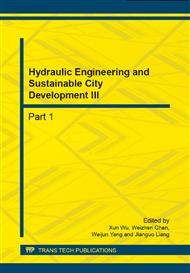p.114
p.119
p.123
p.127
p.132
p.137
p.141
p.145
p.149
Trend Analysis on the Flow Alteration in the Nature Reserve, Upstream of Yangtze River
Abstract:
National Nature Reserve for the Rare and Endemic Fishes in the Upper Reaches of the Yangtze River (RURYR) in China has been established to protect the extraordinarily perfect aquatic ecosystem since 2005. However, four cascade hydropower stations located in the upstream of RURYR will impound and generate electricity gradually, which may change the natural flow regime there. Since flow regime is of great importance to maintaining the healthy and integrity of aquatic ecosystems, it is essential to study the rules of its variation. The flow alteration in RURYR was characterized by Indicators of Hydrologic Alteration (IHA) during 1960-2010, and its trends and the change rules were analyzed for further study on environmental flow and multi-objective optimal operation. The results indicate that in terms of almost no change in total annual runoff, the flow shows a decreasing trend in the flood season, especially in August and October, but an increasing trend in the dry season (from January to June). The variation trend seems reduce the flood risk as a good purpose, however, along with the multi-operation of the cascade reservoirs, the loss of flood peak will increase more significantly, which is harmful to the aquatic ecosystems.
Info:
Periodical:
Pages:
132-136
Citation:
Online since:
September 2014
Authors:
Keywords:
Price:
Сopyright:
© 2014 Trans Tech Publications Ltd. All Rights Reserved
Share:
Citation:


